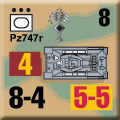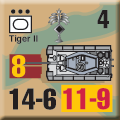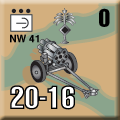| Afrika 1944:
Scenario Preview, Part 2
By Mike Bennighof, Ph.D.
August 2019
 In our last installment, I admitted having broken our own rules with Panzer Grenadier: Afrika 1944, pulling in additional games (and a book) as sources for maps and pieces in constructing the Canary Islands Invasion scenarios. Our expansion books ideally are connected to just one base game, extending its story and drawing on just that one game for pieces and maps. In our last installment, I admitted having broken our own rules with Panzer Grenadier: Afrika 1944, pulling in additional games (and a book) as sources for maps and pieces in constructing the Canary Islands Invasion scenarios. Our expansion books ideally are connected to just one base game, extending its story and drawing on just that one game for pieces and maps.
Afrika 1944 just wasn’t fun enough when constrained in that manner. Once the limits were broken for the Canary Islands, I saw no reason not to do the same for those set on the Moroccan mainland. And so I set about embiggening the scenarios so players could have huge games, either for team play or for weeks of solitaire play. What you do in your game room is between you and your games.
There are three chapters set in Morocco: Americans against the Afrika Korps, Americans against the Italian Mechanized Corps, and the British against both of those. Let’s have a look at Chapter Two.
Chapter Two
Even Nazis Can’t Kill That Fast
With the Canaries secured, Allied troops, weapons and supplies poured into them while airfields new and old accommodated hundreds of planes. Even before the last German and Spanish holdouts had been subdued, the Allies prepared for the next stage of their campaign, hoping to conquer Morocco before the Axis could move in large-scale reinforcements.
Accordingly, U.S. Army forces landed south of Casablanca, catching the Axis by surprise, and met little resistance as they came ashore. But the German Afrika Korps reacted very quickly. The two panzer divisions had been fully equipped with the most modern tanks in the German arsenal, and all of their infantry now rode in armored half-tracked carriers.
Note: All of the chapter titles in Afrika 1944 are quotes from Casablanca.
Scenario Seven
Recon Probe
October 1944
 Having driven off the security forces patrolling the beaches south of Casablanca, the American forward elements probed southward past the coastal plain and into the arid hills. There they encountered German elements moving up according to plan to contest the Allied landings. Having driven off the security forces patrolling the beaches south of Casablanca, the American forward elements probed southward past the coastal plain and into the arid hills. There they encountered German elements moving up according to plan to contest the Allied landings.
Conclusion
The skirmish saw neither side gain the upper hand, but both recon groups fulfilled their mission: they had confirmed that large-scale combat elements were moving on the road between Casablanca and Marrakesh. The fighting there was about to become much more serious.
Notes
We start off with just a little scenario, recon elements against recon elements where speed is more important than firepower. We’ll get to the firepower part soon.
Scenario Eight
Road to Marrakesh
October 1944
Aerial reconnaissance confirmed what the forward scouts had already learned: a large enemy force approached along the road between Casablanca and Marrakesh. Dust clouds made accurate numbers impossible to obtain as both armored divisions deployed for battle.
Conclusion
A furious tank battle raged for hours, with the Americans taking enormous losses among their Sherman tanks but blunting the German advance. Both sides withdrew as nightfall approached. The Germans had been shocked by the tactical skill of the supposedly raw and inexperienced Americans. The Americans for their part had believed their Shermans to be at least the equal of any German tank and had been rattled by the firepower and thick skins of the big new German monsters.
Notes
Now we get to the good stuff: a meeting engagement with eight maps in play and 93 tank units raging across the battlefield (not counting self-propelled guns). Panzer Grenadier is easy to play and intuitive, and allows this sort of scenario to be played by humans within their allotted lifespan. It’s about time we published a few.
Scenario Nine
Speed Bump
October 1944
 Third Armored Division placed its armored infantry across the road to Casablanca, digging them in and backing them with anti-tank guns as best they could. The huge Tiger tanks had proven impossible to stop, falling only to close infantry assaults. But the German Afrika Korps had even larger tanks in its arsenal. Third Armored Division placed its armored infantry across the road to Casablanca, digging them in and backing them with anti-tank guns as best they could. The huge Tiger tanks had proven impossible to stop, falling only to close infantry assaults. But the German Afrika Korps had even larger tanks in its arsenal.
Conclusion
The slow-moving Tiger tanks took enormous punishment from American anti-tank guns but continued to grind forward. American infantry fought them off with improved weapons while the Jackson tank destroyers and Pershing tanks worked around to take flank shots with their 90mm guns. Eventually the Germans withdrew, having inflicted heavy casualties on the defenders but failed to open the road to Casablanca.
Notes
Tiger tanks on the attack. Whole battalions of them, against American 90mm-armed Jacksons and Pershings. Metal against metal, explosions abound. Nine maps, dozens of tanks. This is what you signed up for.
Scenario Ten
Crossing the Regreg
October 1944
As the British drove up the coastal road from Casablanca toward Rabat, the Americans took the inland road toward Meknes. The river Regreg lay astride the road, and the Germans dug in along its banks to defend the line. Capture of the vital rail junction of Meknes would deprive the Germans of supplies and reinforcements coming through Algeria, at least by railroad.
Conclusion
Aided by air strikes and artillery, the Americans forced their way across the river and flanked the Germans defending the bridge. The Americans could make good gains when they did not encounter the massive German tanks, which couldn’t be everywhere, but each success would inevitably be met with a counter-attack.
Notes
We’re back to a merely normal-sized scenario, a desert-ish river crossing with tank-supported Americans fighting their way forward against well-armed Germans with big anti-tank guns and T-34 tanks.
Scenario Eleven
Return of the Tiger
October 1944
 Unable to throw the Allies into the sea, the Germans began to withdraw their forces from southern and central Morocco. That would allow them to hold the northern third of the colony including the important bases facing the Strait of Gibraltar. That also would bring powerful forces northward, like the Afrika Korps’s attached Tiger tank battalion. Unable to throw the Allies into the sea, the Germans began to withdraw their forces from southern and central Morocco. That would allow them to hold the northern third of the colony including the important bases facing the Strait of Gibraltar. That also would bring powerful forces northward, like the Afrika Korps’s attached Tiger tank battalion.
Conclusion
The slowness of the Tiger tanks left them vulnerable to the speedy American tank destroyers, which finally managed to knock out enough of them to blunt the German advance. The Germans took the pass through the mountains and the town of Maaziz on its far side, but the Americans held firm around the bridge over the Regreg.
Notes
This time the scenario’s merely large, with Royal-Tiger-supported infantry on the assault against and American infantry defense (well-supported with anti-tank guns, artillery and airplanes.
Scenario Twelve
Armor at Dawn
October 1944
 American planes spotted the German 15th Panzer Division and supporting units moving on the back roads through the Atlas Mountains. The Germans had chosen to abandon southern Morocco and re-deploy the forces there to protect the more strategically-valuable portion of the colony. The American army commander, George Patton, ordered the Spearhead Division to block the German movement. American planes spotted the German 15th Panzer Division and supporting units moving on the back roads through the Atlas Mountains. The Germans had chosen to abandon southern Morocco and re-deploy the forces there to protect the more strategically-valuable portion of the colony. The American army commander, George Patton, ordered the Spearhead Division to block the German movement.
Conclusion
The Germans broke through the American positions thanks to liberal use of their armor in an infantry-support role, but the Americans re-formed their line slightly to the north. While the Americans lacked the battle experience of the Germans, they had been preparing for years to fight this war and 3rd Armored Division was a well-honed fighting machine.
Notes
Another huge scenario (eight maps’ worth!) as the Afrika Korps tries to break through the Spearhead Division, which has backed its armored infantry with plenty of tanks. So many tanks, you won’t lose the game if you lose a few – scenarios like this don’t punish tiny mistakes, only the big ones.
And that’s Chapter Two, which winds up with a Battle Game. Next, we’ll look at . . . Chapter Three.
Click right here to order Afrika 1944 right now.
Sign up for our newsletter right here. Your info will never be sold or transferred; we'll just use it to update you on new games and new offers.
Mike Bennighof is president of Avalanche Press and holds a doctorate in history from Emory University. A Fulbright Scholar and award-winning journalist, he has published over 100 books, games and articles on historical subjects.
He lives in Birmingham, Alabama with his wife, three children and his dog, Leopold. Leopold is currently in print.
|
